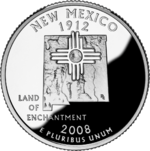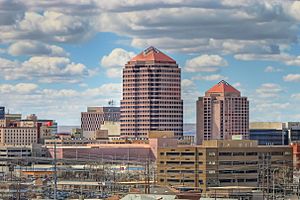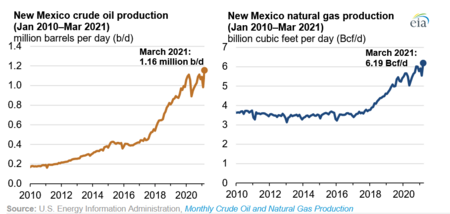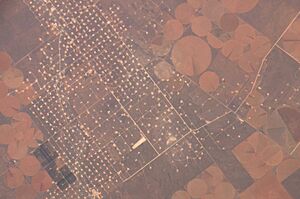Economy of New Mexico facts for kids
 |
|
| Statistics | |
|---|---|
| GDP | $94.2 billion |
|
GDP per capita
|
$39,811 (based on estimated 2017 population of 2,088,070) |
|
Population below poverty line
|
17.1% |
| 0.453 | |
|
Labor force
|
969,872 (September 2023) |
| Unemployment | 3.6% (September 2023) |
| External | |
|
Export goods
|
ADP machine parts (24.5%), processors and controllers (13.0%), medical equipment (4.6%) |
|
Main export partners
|
|
| Public finances | |
| Revenues | $4,413.988 million |
| Expenses | $6,080 million |
New Mexico's economy is powered by several key areas. These include making oil and gas, attracting tourists, and money spent by the U.S. government. The state government helps businesses grow. They offer special tax breaks and support. This encourages new companies, especially in technology, to set up shop here.
In 2017, the total value of all goods and services produced in New Mexico was about $94.2 billion. This is called the gross domestic product (GDP). Also in 2017, the average income for each person was $39,811. This placed New Mexico 48th among all U.S. states. In 2008, about 17.1% of people lived below the poverty level. This means their income was not enough to meet basic needs.
Contents
New Mexico's Main Industries
New Mexico has many different types of businesses. Some of the biggest industries include retail (stores that sell directly to people) and construction. Other important areas are professional services, like science and technology. Hotels and restaurants also bring in a lot of money. Health care, utilities, and mining are also big parts of the economy.
Farming and Mining
New Mexico's farms produce a lot of cattle and dairy products. Cows, sheep, and other animals graze on much of the state's land all year.
Farmers also grow crops, even with limited water. This is called dryland farming. Important crops include hay, plants from nurseries, pecans, and chile peppers. Hay and sorghum are major dryland crops. Farmers also grow onions, potatoes, and make dairy products. Special New Mexico crops include piñon nuts, pinto beans, and, of course, chiles.
Water for farming comes from special projects. The Carlsbad and Fort Sumner projects use water from the Pecos River. The Tucumcari project also helps. These projects provide water for farming in dry areas. The Elephant Butte Reservoir on the Rio Grande is a major water source. It helps farms near Las Cruces. Other projects use water from the Colorado River and San Juan River.
Lumber mills in Albuquerque process pinewood. This wood comes from the rich forests of Northern New Mexico.
Mining is another big part of New Mexico's income. Long ago, Native Americans mined turquoise for jewelry. Later, they used silver too. Today, New Mexico mines uranium ore, manganese ore, potash, salt, perlite, copper ore, beryllium, and tin.
Energy Production
New Mexico has lots of energy resources. These include fossil fuels and newer, cleaner energy sources. Large amounts of oil and natural gas are found in the Permian Basin in the southeast. They are also in the San Juan Basin in the northwest. The San Juan Basin has the largest proven natural gas reserves in the U.S.
New Mexico produces about 3% of the U.S. crude oil. It also produces nearly 10% of the U.S. natural gas. The state also has big coal deposits in the northwest. New ways of drilling, like hydraulic fracturing (fracking) and horizontal drilling, have greatly increased oil production since 2010. This helped the U.S. become the world's largest oil producer again in 2018.
New Mexico's oil and gas operations release a lot of methane. Methane is a greenhouse gas. There's even a "methane hot spot" in the Four Corners area. Most of the state's electricity (nine-tenths) comes from coal-fired power plants.
The Rocky Mountain region in New Mexico has potential for geothermal power. This uses heat from inside the Earth. Some parts of the state are also good for wind power. The southern deserts are perfect for solar power.
The Waste Isolation Pilot Plant (WIPP) is in the Delaware Basin. It is used to store nuclear waste safely underground.
Manufacturing
Manufacturing in New Mexico is mostly around Albuquerque. Factories here make electric equipment. They also produce petroleum and coal products. Other goods include processed foods, printed materials, and glass products. Industries related to defense make things like weapons. High-tech industries are also important. These include lasers, data processing, solar energy, and computer chips (semiconductors).
Tourism and Retirement
Tourism is a big business in New Mexico. In 2006, visitors spent about $6.5 billion in the state.
Virgin Galactic is a company that plans to take people to space. They chose Spaceport America in Upham, New Mexico for their headquarters. This spaceport is near Truth or Consequences. Virgin Galactic launched its first spaceship, VSS Enterprise, in 2008. They started launching regular people into space in 2009.
Many people have moved to urban areas of New Mexico, especially Albuquerque. This has helped the service economy grow. After World War II, many retired military and government workers moved there. Albuquerque is also known as a health-focused community. It has many hospitals and therapists. The warm, dry climate attracts new industries. However, many rural communities, especially those with large Native American and Hispanic populations, still face economic challenges.
Arts and Entertainment
New Mexico has been a popular place for filming movies since 1898. The state offers money and builds facilities, like The Albuquerque Studios. This has created many jobs for local film crews. In 2007, a record 30 major film projects were shot in the state. The New Mexico Film Office helps film companies come to the state.
In 2011, the state put a limit on tax credits for the film industry. This was because the cost of these incentives grew very quickly. It went from $3.4 million in 2004 to $76.7 million in 2009.
Meow Wolf is an artist collective that started in Santa Fe. It has grown to other states like Colorado, Nevada, and Texas. Famous artists like George R. R. Martin have been involved.
Filming Facilities
Garson Studios is a film production facility at Santa Fe University of Art and Design. It has soundstages and high-tech equipment. Many feature films have been made there. Post-production work for film and TV is also growing in the state.
Technology
In 2023, the U.S. Department of Energy announced new projects in New Mexico. These projects are part of the CHIPS and Science Act. This act aims to boost making computer chips in the U.S. It also supports new technology research and training workers. The projects will total about $8 million. They include a new 100,000-square-foot technology incubator. This incubator will help companies, universities, and national labs work together. There will also be a new platform to help tech startups from minority communities. Besides government funding, business leaders like Richard Branson and Elon Musk are also investing in technology in New Mexico and the Southwest.
Taxes in New Mexico
New Mexico has different types of taxes.
- Income Tax: Since 2008, personal income tax rates range from 1.7% to 4.9%. The rate depends on how much money a person earns. Since 2007, salaries for active-duty military members are not taxed by the state.
- Gross Receipts Tax: New Mexico has a gross receipts tax on businesses. This is like a sales tax, but it applies to services as well as goods. Businesses usually add this tax to the price for the customer. Both the state and local cities or counties can charge this tax. As of July 1, 2008, the total tax rate was between 5.125% and 8.4375%.
- Property Tax: Property tax is charged on real estate by the state, counties, and school districts. Most personal belongings are not taxed. The taxable value of a property is one-third of its total value. A tax rate of about 30 mills is applied to this taxable value. This means the actual tax rate is about 1%. In 2005, the average tax rate was about 26.47 mills for homes and 29.80 mills for other properties. The assessed value of homes cannot increase by more than 3% per year. This rule changes if the home is remodeled or sold.
Economic Support
New Mexico offers many ways to help businesses. These are called economic incentives. They include different types of tax credits and tax exemptions. Most of these benefits are given to businesses that create new jobs.
New Mexico law allows local governments to provide land, buildings, and other resources to businesses. This helps create more jobs. Some cities and counties have a special tax called an economic development gross receipts tax. This money is used to pay for improvements and to attract businesses.
The state also gives money to help film productions. The New Mexico Film Office estimated that by the end of 2007, this program had brought over 85 film projects to the state since 2003. It also added $1.2 billion to the economy.
Largest Employers
Here are some of the biggest employers in different parts of New Mexico:
- Northern New Mexico:
- Santa Fe University of Art and Design
- Boy Scouts of America
- U.S. Bureau of Land Management (BLM)
- Mesa Air Group
- Navajo Nation
- Los Alamos National Laboratory
- Wal-Mart
- New Mexico State Government
- New Mexico Department of Transportation
- Northern New Mexico College
- Central New Mexico:
- PNM Resources and PNM Electric & Gas Services
- Presbyterian Health Plan
- Sandia National Laboratories
- Intel
- University of New Mexico
- New Mexico State Government
- Kirtland Air Force Base
- Eastern New Mexico:
- Albertson's Supermarket
- U.S. Postal Service
- Wal-Mart
- Navajo Refining Company
- U.S. National Park Service (NPS)
- Allsup's Convenience Stores
- Southwestern New Mexico:
- Immigration and Naturalization Service (INS)
- Lockheed Engineering and Sciences
- New Mexico State University
- Lovelace Healthcare
- Pepsi Bottling
- New Mexico Institute of Mining and Technology
- U.S. Army (Fort Bliss)




